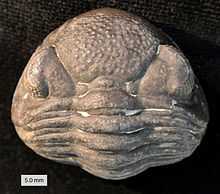Phacopidae
| Phacopidae Temporal range: Ordovician–Devonian | |
|---|---|
 | |
| Phacops rana from the Devonian of Ohio. Scale bar is 5.0 mm. | |
| Scientific classification | |
| Kingdom: | Animalia |
| Phylum: | Arthropoda |
| Class: | Trilobita |
| Order: | Phacopida |
| Suborder: | Phacopina |
| Superfamily: | Phacopoidea |
| Family: | Phacopidae Hawle & Corda, 1847 |
Phacopidae constitute a family of trilobites of the order Phacopida, that includes species that occurred from the Lower Ordovician to the Upper Devonian and had representatives in all paleocontinents.[1]
Description


Like in all Phacopina, the eyes (if present) consist of very large (0.5mm in Phacops rana), separately set lenses without a common cornea (so called schizochroal eyes). However, several phacopids have very few lenses, such as the species of the genera Cryphops, Denckmannites, Dienstina, Eucryphops, Nephranops, and Plagiolaria, or lack eyes altogether, like Dianops, Ductina, and Trimerocephalus. The natural fracture lines (sutures) of the head run along the top edges of the compound eye. From the back of the eye these cut to the side of the head (proparian) and not to the back. In front of the eye, the right and left facial sutures connect in front of the inflated glabella and consequently the free cheeks (or librigenae) are yoked as a single piece. In some of the eyeless genera (Ductina) the suture coincides with the marginal suture, and thus appears to be absent. The part of the skeleton that is ‘tucked under’ (the doublure) has no sutures crossing it to form a rostral plate. The thorax has 11 (rarely 10) segments, the side lobes (or pleurae) are furrowed, and the articulating facets distinct. The tailshield (or pygidium) is always smaller than the headshield (or cephalon), a situation called micropygous.
In the Phacopidae a merger of the anterior and the two pairs of neighbouring lobes of the glabella forms a frontal lobe that expands forward and can be inflated and overhanging the frontal border. To the back of the glabella two furrows (or sometimes one) cross the glabella forming two rings ("intercalating ring" and "occipital ring"). The cephalon does not end in genal spines. The side lobes of the thorax (or pleurae, singular pleura) have rounded ends. The pygidium is well rounded, semicircular or shorter, with an entire margin, and without lateral and posterior projections. In many Phacopidae, where the facial sutures are apparently continuous and well developed, they were evidently nonfunctional in ecdysis, since no separate free cheeks can be found.[1]
Genera
The following genera are included:[2]
|
|
|
|
References
- ↑ 1.0 1.1 Moore, R.C. (1959). Arthropoda I - Arthropoda General Features, Proarthropoda, Euarthropoda General Features, Trilobitomorpha. Treatise on Invertebrate Paleontology. Part O. Boulder, Colorado/Lawrence, Kansas: Geological Society of America/University of Kansas Press. pp. 1–560. ISBN 0-8137-3015-5.
- ↑ S.M. Gon III. "Order Phacopida". Retrieved January 15, 2011.